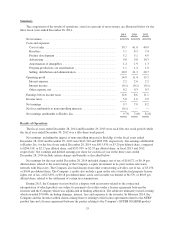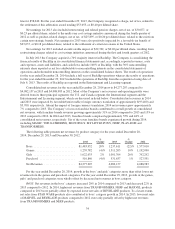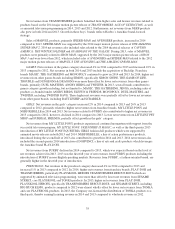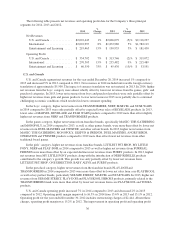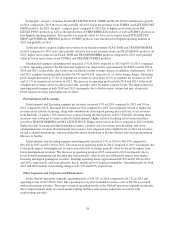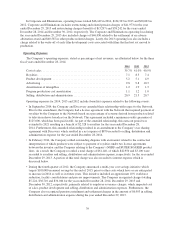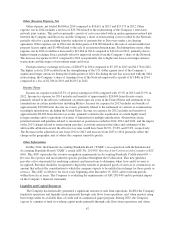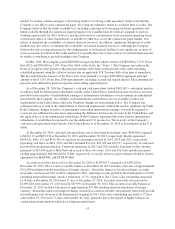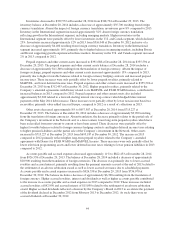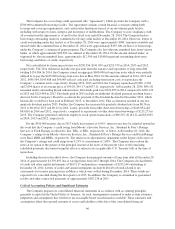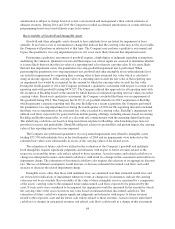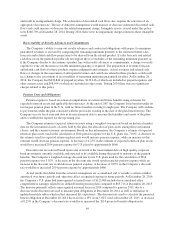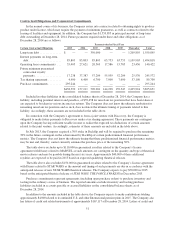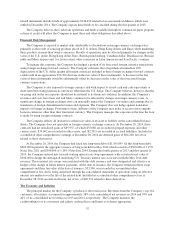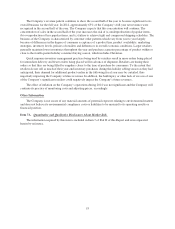Hasbro 2014 Annual Report Download - page 57
Download and view the complete annual report
Please find page 57 of the 2014 Hasbro annual report below. You can navigate through the pages in the report by either clicking on the pages listed below, or by using the keyword search tool below to find specific information within the annual report.needed, by issuing commercial paper or borrowing under its revolving credit agreement. In the event that the
Company is not able to issue commercial paper, the Company intends to utilize its available lines of credit. The
Company believes that the funds available to it, including cash expected to be generated from operations and
funds available through its commercial paper program or its available lines of credit are adequate to meet its
working capital needs for 2015, however, unexpected events or circumstances such as material operating losses
or increased capital or other expenditures, or inability to otherwise access the commercial paper market, may
reduce or eliminate the availability of external financial resources. In addition, significant disruptions to credit
markets may also reduce or eliminate the availability of external financial resources. Although the Company
believes the risk of nonperformance by the counterparties to its financial facilities is not significant, in times of
severe economic downturn in the credit markets it is possible that one or more sources of external financing may
be unable or unwilling to provide funding to the Company.
In May 2014, the Company issued $600,000 in long-term debt which consists of $300,000 in 3.15% Notes
Due 2021 and $300,000 in 5.10% Notes Due 2044 (collectively, the “Notes”). The Company may redeem the
Notes at its option at the greater of the principal amount of the Notes or the present value of the remaining
scheduled payments using the effective interest rate on applicable U.S. Treasury bills at the time of repurchase.
The proceeds from the issuance of the Notes were used, primarily, to repay $425,000 in aggregate principal
amount of the 6.125% Notes Due 2014 upon maturity, including accrued and unpaid interest. The remaining net
proceeds were utilized for general corporate and working capital purposes.
As of December 28, 2014 the Company’s cash and cash equivalents totaled $893,167, a substantial portion
of which is held by international subsidiaries outside of the United States. Deferred income taxes have not been
provided on the majority of undistributed earnings of international subsidiaries as such earnings are indefinitely
reinvested by the Company. Accordingly, such international cash balances are not available to fund cash
requirements in the United States unless the Company changes its reinvestment policy. The Company has
sufficient sources of cash in the United States to fund cash requirements without the need to repatriate any funds.
If the Company changes its policy of permanently reinvesting international earnings, it would be required to
accrue for any additional income taxes representing the difference between the tax rates in the United States and
the applicable tax of the international subsidiaries. If the Company repatriated the funds from its international
subsidiaries, it would then be required to pay the additional U.S. income tax. The majority of the Company’s
cash and cash equivalents held outside of the United States as of December 28, 2014 is denominated in the U.S.
dollar.
At December 28, 2014, cash and cash equivalents, net of short-term borrowings, were $640,686 compared
to $674,117 and $625,336 at December 29, 2013 and December 30, 2012, respectively. Hasbro generated
$454,411, $401,132 and $534,796 of cash from its operating activities in 2014, 2013 and 2012, respectively.
Operating cash flows in 2014, 2013 and 2012 included $31,424, $41,325 and $59,277, respectively, of cash used
for television program production. Cash from operations in 2013 and 2012 includes long-term royalty advance
payments of $25,000 made to Hub Network in each of those two years. 2014 and 2013 also includes payments
totaling approximately $60,000 and $175,000, respectively, of royalty advances paid to Disney related to license
agreements for MARVEL and STAR WARS.
Accounts receivable, net was flat at December 28, 2014 at $1,094,673 compared to $1,093,620 at
December 29, 2013. The accounts receivable balance at December 28, 2014 includes a decrease of approximately
$111,900 resulting from the translation of foreign currency. Absent the impact of foreign exchange, accounts
receivable, net increased 10% in 2014 compared to 2013, reflecting revenue growth in the fourth quarter of 2014,
excluding unfavorable foreign currency translation, of 7% compared to 2013. Days sales outstanding decreased
to 76 days at December 28, 2014 from 77 days at December 29, 2013. Accounts receivable, net increased to
$1,093,620 at December 29, 2013 from $1,029,959 at December 30, 2012. The accounts receivable balance at
December 29, 2013 includes a decrease of approximately $17,000 resulting from the translation of foreign
currency. Absent the impact of foreign exchange, increased accounts receivable, net primarily reflects the growth
in fourth quarter net revenues in the International segment in 2013. Days sales outstanding increased to 77 days
at December 29, 2013 from 72 days at December 30, 2012, primarily due to the impact of higher balances in
certain international markets which have longer payment terms.
43


